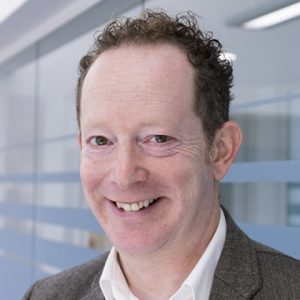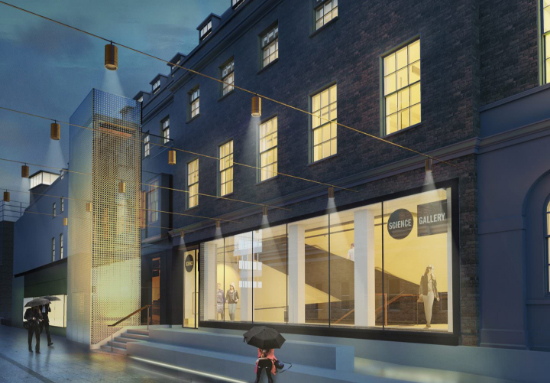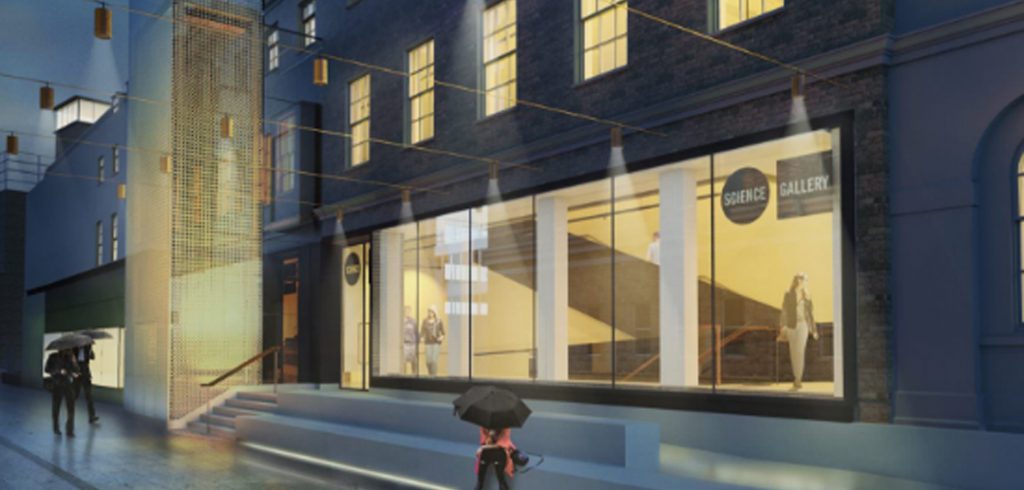"Ich glaube immer noch, dass die Wissenschaft nach Antworten und die Kunst nach Fragen sucht." - Marc Quinn
Aiming to bridge the gap between science and art, King’s College London is all set to open Wissenschaftsgalerie London, a new space in the heart of the capital, where ‘science and art collide’. The gallery is part of the Global Science Gallery Network and will open its doors to the public in 2018. The free-to-visit space seeks to spark creative thinking and innovation, through collaborations not only between scientists and artists, but also between local communities, students, educators, young researchers, and people like you and me. The gallery will host exhibitions, events, live experiments and interactive discussions, serving as a channel through which King’s researchers can connect and engage with the outside world.

Dr. Daniel Glaser | Bild: © Kate Anderson, mit freundlicher Genehmigung der Science Gallery London
The Director of Science Gallery London, Dr. Daniel Glaser, is a neuroscientist, and former head of Engaging Science at Wellcome Trust. He was also the first scientist to serve as a judge for the Man Book Prize, and was the first Scientist in Residence at the Institute of Contemporary Arts in London. I chat with Dr. Glaser over the phone about Science Gallery’s vision, and the need for interdisciplinary collaboration.
RS: Wie ist die Idee zur Science Gallery entstanden? Welchen Bedarf gab es für einen Raum wie diesen?
DG: Die Science Gallery wurde 2008 in Dublin gegründet. Die Notwendigkeit der Galerie ergibt sich aus einer Kombination von zwei Dingen. Sie entstand aus einer künstlerischen Bewegung, die Wissenschaft und Kunst miteinander verband - mit der Idee, dass diese beiden Disziplinen nicht getrennt sein sollten. Es war auch das Ergebnis einer langen Reihe von Arbeiten, die von Leuten wie dem Wellcome Trust finanziert wurden - wo künstlerische Produkte den Menschen halfen, eine Verbindung zur Wissenschaft herzustellen.
The second motivation for us at King’s is for the university to be able to connect to the city. We’ve got the gallery on the corner of the campus on a very busy street, so it’s a mechanism or a channel through which we can connect with the city.

An architect’s representation of Science Gallery London | © LTS Architects, Courtesy Science Gallery London
RS: Why do you think it’s important for scientists and artists to collaborate?
DG: The right way to think about it would be to think of the concept of interdisciplinarity. If we want to make progress in society, in science, in art, and in life – we need to have people from different backgrounds and traditions freely engage and interact with each other. We have different beliefs, different ways of talking and acting, there are differences in religion, nationality, scientific practice, art, etc. If a university has to thrive, if Forschung has to thrive and the problems of society have to be solved, then we need to have these spaces where people from different perspectives come together.
Wir sprechen hier nicht nur von Biologen und Chemikern, sondern auch von Nanotechnologen, Ingenieuren und Designern. Dyson stellt technische Produkte her, (Sir) Jonathan Ive, der Designer des iPhones, ist jemand mit einem Design-Hintergrund, der für ein technisches Unternehmen arbeitet. Wir müssen diese Art der Zusammenarbeit fördern.
RS: Auf der KCL-Website habe ich gelesen, dass sich die Galerie auf die Zielgruppe der 15- bis 25-Jährigen konzentriert und dass Sie sie um Ideen für neue Vorschläge bitten. Warum gerade diese Altersgruppe?
DG: Es gibt also zwei Gründe. Ich möchte Sie fragen, wie alt Sie werden wollen?
RS: 22!
DG: Exactly, mine’s 24 – that’s actually the median age. Both groups – younger and older – who were asked this question, pick this age range. This is also an under-served age group. Typically science museums are targetted to a much younger age group, whereas the more serious exhibitions involve scientists having a panel discussion after which we share a glass of wine – this age group falls in between the two.
Für unsere erste Ausstellung zum Thema Sucht, Hooked, mit der wir 2018 eröffnen, haben wir diese Altersgruppe gefragt, was sie über Sucht denkt. Wir haben Antworten über Heroin, Drogenspritzen und Alkohol erwartet. Aber können Sie erraten, worüber sie sprachen?
RS: Telefone?
DG: Exactly, mobile phones and social media. So when we open, the exhibition will not only focus on alcohol and drugs but also things that we didn’t think of as obvious themes. Young people bring in a new perspective.
RS: Kann ich auch einen Vorschlag einreichen, wenn ich nicht in der Altersgruppe bin?
DG: Absolutely. Also, we aim for 40% of our audience to be within the age group of 15-25 and the rest are outside that bracket. We have an open proposals system where just about anyone can send in a proposal. You needn’t have to be in that age group.
Aber sobald wir uns für ein Thema entschieden haben, gehen wir als Erstes los und fragen die 15- bis 25-Jährigen, was sie darüber denken.
RS: Was sind Ihre Kriterien für die Vergabe von Projekten?
Well, the person who takes the call is someone who’s had curatorial experience, someone who’s had years of experience in putting on exhibitions. So far, the problem with SciArt galleries was that we had a scientist or, even worse, an admin making the decision but that’s not how it is here. Of course, the project has to have künstlerische Spitzenleistungen und sollten für ein junges Publikum spannend und fesselnd sein.
Wir zeigen nicht nur die Arbeiten, die im Rahmen der offenen Ausschreibungen eingereicht werden, sondern auch andere Projekte, die diese ergänzen.
RS: How do you get somebody who’s not in the UK to engage with this space?
DG: Anyone from any part of the world can make a proposal – we’ve commissioned projects from Taiwan, China, Italy – the world over. Though we say the proposals system is ‘open’, we typically get proposals from people who understand science and art. We also expect the ideas to engage underactive groups.
RS: Ich habe über den Spuckkristall-Projekt. Glauben Sie, dass die Fragen/Schlussfolgerungen, die sich aus dieser Art von Projekten ergeben, die Forschung und Innovation am KCL und außerhalb anregen werden?
DG: I’m really glad you bring up the spit crystal because it’s one of the most fascinating projects we’ve had. We had Inés Cámara Leret, a young artist in her 20s, send in this proposal. At the gallery, she ended up meeting Brian Sutton, a senior professor of X-ray crystallography, who worked under the same supervisor as Rosalind Franklin. Now, Inés was making the crystal not just by spit but by adding alum to it. Professor Brian Sutton was so intrigued that he now has actually got a postdoc working with him on generating spit crystals from protein in the saliva.
We’ve had lots of such examples, but not every artistic idea will go through the same interaction. It’s not something that happens automatically – you need the right kind of experienced mentors who can take the idea forward. What we want is for projects to raise questions that enable us to look at the world around us in a different light.
RS: Wie war die bisherige Resonanz auf die Ausstellungen?
DG: We’ve been doing pop ups all over the city. I’ve been in this field for about 20 years now, and I can say that the response has been extremely positive. We’ve had hundreds to thousands of people looking at artworks and thinking about themselves and the world around them in a different way.
Wir haben auch studentische Mediatoren vom KCL, die wir dafür bezahlen, mit den Besuchern zu interagieren. Wir haben am Wochenende eine dieser Interaktionen erlebt, und es war absolut faszinierend, das Gespräch zwischen dem Publikum und den Studenten zu beobachten. Es gab so viele Fragen, die dabei aufkamen - und ich denke, diese Fragen sind wichtig, damit wir Fortschritte machen können.
Die Science Gallery London veranstaltet die Ausstellung und Veranstaltungsreihe Blood: Life Uncut , vom 27.07.17 - 1.11.17, die die verschiedenen Möglichkeiten untersucht, wie Blut Menschen fesseln und zusammenbringen kann.
RS: In Ihrer Rede auf der EHD2017 haben Sie erwähnt, dass Interdisziplinarität mit Unwissenheit zu tun hat. Glauben Sie, dass ein Ort wie die Science Gallery London dazu beiträgt, diese Unwissenheit zu beseitigen und die Forschung inklusiver zu machen?
DG: Well, I don’t think we should entfernen ignorance. By ignorance, I mean the disciplines we specialise in – we all think and speak a certain way, we interact with others who think like us. Discipline refers to expertise or knowledge in one particular area. That is inhomogenous too – its not the same everywhere. So, I don’t think that we should be removing this ignorance, but we should be permitted to ask questions.
Often, stupid questions are the best ones. In English, we even say it to defend ourselves – “Ah, this is probably a stupid question” – but these questions are the ones that are critical for us to make progress. ‘Ignorance’ is a new energy source for us to capitalize on.
RS: Glauben Sie, dass die Zukunft der Wissenschaft in der Zusammenarbeit liegt? Ich frage das vor allem, weil ich für eine Organisation arbeite, die die interdisziplinäre Zusammenarbeit fördert.
DG: Yes, but I don’t think the majority of papers should be about that. When I started doing a PhD in Neurowissenschaften, there were no professors studying neuroscience, the term didn’t really exist. Disciplines shift over time, and not all collaborations are fruitful. Not all survive.
What I think is important is periodic engagement outside your comfort zone. If you’re a researcher, you spend most of your time in the lab, talking to people who think just like you. When you get out of that zone, you start to make progress. We are so comfortable in our space – I think exploring and engaging with the world outside of it is important.
RS: Gibt es eine Botschaft, die Sie jungen Forschern und Künstlern mit auf den Weg geben möchten?
DG: Well. I’d say, be brave and respectful, which are also the values of the Science Gallery. Look for ways to connect with others, and participate. Most importantly, never be scared to surprise yourself and others.
----------
Lesen Sie mehr über laufende Veranstaltungen in der Science Gallery London hier.
